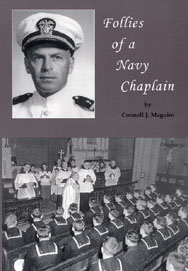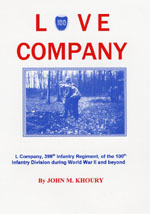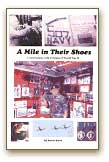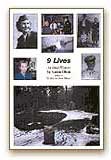Preface to the Expanded 2nd Edition
By Aaron Elson
©2014, Aaron Elson
"When they were eight or nine, my grandchildren asked me about the war. I told them, 'You don't want to know about it. You'll read it in history." --Ed Spahr, gunner
Preface
When I was a child, I loved hearing my father’s stories about World War II. He managed to make the act of being wounded sound funny. "I had never been in a battle," he used to say, "so I stuck my head up to see what was going on." Among other things, he said, a bullet went through his helmet, and some tissue paper wadded inside saved his life.
My father, Maurice Elson, trained with the infantry. He went to Officers Candidate School at Fort Benning, Ga., and was assigned to the 712th Tank Battalion in Normandy as a replacement.
That was the first time he was wounded. I only heard him talk a few times about the second time. It was in December and there was snow on the ground, it was at night and in a place called Dillingen. He said he was hit by a German machine gun bullet that entered his chest an inch from his heart, and that the bullet was extracted from his arm. The doctors even gave him the bullet.
Several years after he died of a heart attack in 1980, I came across a newsletter addressed to my father. It was put out by the 712th Tank Battalion, and it chronicled the ordinary, but rarely mundane, lives of the battalion’s members. It mentioned the grandchildren, the retirements, the visits, the surgeries, and it reminded its readers that nobody was growing any younger.
I wrote to the newsletter’s editor, Ray Griffin, in Aurora, Neb., and asked if he would put in a notice asking anyone who remembered my father to contact me. Griffin passed my letter on to Sam MacFarland, a veteran of A Company, to which my father had been assigned. MacFarland wrote and said he didn’t remember my father, but that I would be welcome to attend the battalion’s next reunion, where I might find some people who did.
That reunion was in Niagara Falls, in 1987. I met three people – Jule Braatz, Charlie Vinson and Ellsworth Howard – who remembered my dad, and the stories I only vaguely remembered suddenly came to life. It was an exhilarating feeling.
The battalion members welcomed me as if I were part of a large, extended family, and I have been to several reunions since.
Jim Gifford joined the 712th Tank Battalion as a replacement in Normandy, and was wounded during the Battle of the Bulge. Today Gifford is a lawyer in Yonkers, N.Y., where he also runs a used-car lot. He works seven days a week, and still has a country-lawyer charm that came from growing up in Gloversville, N.Y.
In a philosophical moment, Gifford says that during the war he experienced a kind of calm he had never felt before and has not felt since. It was the calm that came with knowing he wasn’t going to survive. Suddenly, all the pressure of worrying about school, about a career, about making a living, was lifted from his shoulders.
Forrest Dixon, the battalion’s maintenance officer, also says he didn’t expect Gifford to survive the war.
"If the tank pulled up in front of a building," Dixon says, chuckling, "Lieutenant Gifford would get out and go around in back of the building to see if any Germans were hiding there with a bazooka!"
Tony D’Arpino lives in the Boston suburb of Milton, and Ruby Goldstein in the Boston suburb of Hull. After the war, Goldstein opened a dry cleaning establishment and D’Arpino was one of his customers. It wasn’t until they met at a reunion, however, that D’Arpino – who was in C Company – and Goldstein, of A Company, realized they had belonged to the same outfit.
Goldstein, a tank commander, was wounded at the Falaise Gap in August of 1944. D’Arpino, a driver, was one of only six of C Company’s roughly 75 original members to make it from Normandy to Czechoslovakia without being wounded, unless you count the fact that his eardrums were perforated when his tank went over a mine, and he has suffered from ringing in his ears ever since.
As I was interviewing Bob Hagerty in a hallway outside a meeting room at the Harrisburg, Pa., Sheraton during the 1992 reunion, one of the tankers’ wives passed by. She leaned toward the microphone and said a little giddily, "Every year they fight the war all over again, and every year it comes out the same!"
Every year, though, it has fewer participants. Many of the battalion members are in their eighties. Most wear hearing aids, and a part of each reunion is spent in catching up on medical histories.
But for a few days each year, these frail, elderly men are young again, clattering in Sherman and Stuart tanks across rivers on pontoon bridges, barreling full-tilt along ice-slicked roads, and bringing back to life, for a few flickering moments, the memories of those who are buried in the cemeteries of France and Belgium and Luxembourg, or whose remains were reburied after the war in cemeteries all across America, or whose ashes remain in the fields and orchards where they burned inside their tanks.
After I began writing the original "Tanks for the Memories," which I published in 1994, I visited the battalion’s monument in the memorial garden of the Patton Museum in Fort Knox, Ky. It was a sobering moment. I had interviewed so many tankers and heard so many stories that I thought I knew a great deal about the history of the 712th. But when I started going through the names of the battalion members killed in action, I recognized barely half of them.
It would be impossible to write a comprehensive history of the 712th Tank Battalion. Their record-keeping at times was lax; their unit history lists places and dates where tanks were lost, but lacks names to go with them; and I didn’t begin interviewing the battalion’s veterans until more than 40 years after the war. Sometimes the accounts of two or three men who were at the same place at the same time differ sharply, and there is no way of verifying whose account was correct. As Jim Flowers, who left part of both of his legs in a bloody field in Normandy, put it: "If that’s the way he remembers it, then that’s what happened as he remembers it."
The 712th Tank Battalion landed in Normandy on June 28, 1944, and was on the front lines in France, Luxembourg, Belgium, Germany and Czechoslovakia for 11 months. It took part in the breakout at St. Lo and helped encircle the German 7th Army at the Falaise Gap. It dashed across France with General George S. Patton’s vaunted Third Army. It crossed a flooded Moselle River in November and the Saar in December and the Moselle again and the Rhine in March of 1945. It took part in the Battle of the Bulge and breached the Siegfried Line. It guarded the treasures of the Merkers Salt Mine and witnessed the horrors of the Flossenburg concentration camp.
Of the 1,235 men who passed through the battalion’s ranks, 101 were killed in action. Its members received one Legion of Honor, two Distinguished Service Crosses, eight Croixs de Guerre, 56 Silver Stars, 362 Bronze Stars, two Presidential Unit Citations, and 498 Purple Hearts.
One of those Purple Hearts belonged to Quentin "Pine Valley" Bynum, a tank driver with whom my father hitched a ride to the front shortly after he joined the battalion in Normandy. My father got a Purple Heart of his own that day, which was most likely July 12 or 13 of 1944. Bynum remained in combat for six more months, and received his Purple Heart posthumously. He was killed in action on Jan. 14, 1945.
"I was thinking a while ago that he would be 79 years old," James Bynum, one of Quentin’s eight siblings, said when I visited him in Springfield, Mo., in 1997. "I’m 73, and I had two older sisters and then Quentin. We figured out one time that my mother was pregnant seven years, and delivered almost 100 pounds of babies."
Quentin Bynum volunteered for the draft in 1941 when he was 23 years old. He had his basic training at Fort Riley, Kansas, and was sent to the 11th horse Cavalry at Camp Lockett, California. Early in 1943, the 11th Cavalry was transferred to Fort Benning, Georgia, where it was mechanized as part of the newly formed 10th Armored Division.
"We had a granddaughter who was born March 29th," James Bynum said. "My daughter was suffering from high blood pressure and they thought for a while that they were going to lose both of them, and they delivered the child when she was either in the 24th or 26th week of pregnancy. I told the baby’s doctor that the irony was that the baby weighed one pound, three and a half ounces, and I had weighed 14 pounds when I was born.
"He said, ‘Did your mother have diabetes?’
"I said, ‘No, she was just a big woman and they didn’t know how to take care of the pregnancy at that time.’ And my brother Harry weighed 12 pounds. I told him that when Harry was born, my mother sat up on the side of the bed and fed him mashed potatoes and gravy.
"The doctor said, ‘My God, and he lived?’
"I said, ‘Yes. In Patagonia, when a baby was born, they’d throw the mother and the baby into the ocean, and if they got ashore they were going to live.’
"And he said, ‘Well, the Patagonians didn’t know any better. Your mother should have.’"
James said Quentin almost died when he was six or eight months old. In fact, the doctor had pronounced him dead of diphtheria during an epidemic in the early 1920s, but Quentin’s mother refused to believe him and blocked the door until the doctor told her how she could bring young Quentin back to life.
"He told her to wrap the baby in a blanket and warm him by the fire of the cookstove," James said, "and then he left."
Quentin’s mother followed his instructions, and the infant returned from the dead. But that short period in which his brain received insufficient oxygen may have affected him as he grew up, James said. Quentin had a difficult time in school, and when he was 16 his father allowed him to drop out and do chores on the farm. Most of his siblings went on to more intellectual pursuits, including James, who became a college professor.
On Thursday, Jan. 11, 1944, "we had hamburgers and ice cream for chow," Phil Eckhart, a replacement in Bynum’s platoon, wrote in a diary that he kept. Charles Vorhees, another member of his platoon, made the ice cream by mixing snow with cocoa powder from the 10-in-1 rations.
"During the night it snowed," Eckhart wrote, "and when we got up it was about two feet deep. That night I had slept in the tank, as the night before I had just about froze out under the tarp. When I went to put my shoes on for guard they were frozen stiff, and I had a hard time getting my overshoes over them. Well, as I was saying before, I had slept in the tank that night, and kept pretty warm. When the other fellows woke up, they had to dig their way out through the snow. It was Friday, the 12th of January. We ate chow and pulled out for the next town. As we were going through a field, we met about two thousand prisoners coming back. We stopped there for a while and got out of the tanks. All of a sudden the Germans started to throw in the artillery, and we made a dash for our tanks. One of the shells hit just as I was going in, and I heard the assistant driver call out. The concussion had knocked him down. His hatch was open, and when they had quit he made a dash for it. Not very far from there had been a mare and her colt walking around a haystack. When we came out they were both laying there dead.
"About three tanks behind us the driver and an infantry lieutenant were hit. The tank driver was Roy Sharpton, and he died later on. We asked the captain how he was, and they said that he was improving, next thing we knew he was dead. I have a ten dollar bill out of my first Army pay, and one of the names I have on it is his. Well, that night about nine we pulled into a woods, and waited for orders to move into town. I was on guard from twelve to one, and I had just got off, and was ready to get in my sleeping bag, when they called for us. We moved into town, and I did not get very much sleep that night.
"Next morning, which was on Saturday the 13th of January, we were to go and get some prisoners in a barn. We started down through the field, and there were three Germans running towards the woods. My .30-caliber had jammed, and the gunner asked me if the 76 was loaded. He fired a high-explosive at them, and hit one of them square. Well, you can imagine what happened to him. We went on down to the barn, and found out there was nothing there, so we started back to where we had been. When we went back we were in the rear, and could see that the Germans were firing at the tanks ahead. They hit two ahead of us, but not bad enough to stop them. We were just about behind a building when they hit us in the rear on the right side and knocked out our motor. I was sitting in the turret with an H.E. [high-explosive shell] in my hands, but it did not take long to get rid of it and get out. They kept throwing armor-piercing at us, and I was glad it was not H.E. Later on the driver went back to pull the fire extinguishers, and to shut off the master switch. While he was leaning in to shut off the switch, the Germans took a piece of the gun off right over his head with an A.P. [armor-piercing shell]. Later on, he was put in for the Bronze Star; that gave him one cluster.
"Next day, which was on Sunday, the 14th of January, the crew, all but the Lieutenant, went back to get a new tank. Our gunner got the projectile that knocked us out. I don’t know if he took it home with him or not. When we were on our way back to the company in the ammo truck, our own planes started to bomb and strafe us. We got out and ran in an old building. The fellows were firing at them with the rifles on their peeps [small jeep-like vehicles], and some were firing at them with M-1 rifles. Later on we found out that they thought the Germans were still in the town, as there were a lot of German vehicles knocked out.
"We got back to the company and slept in a barn that night. Next morning we got the sad news that our Lieutenant and two other men had been killed that night. When our tank was knocked out the Lieutenant took No. 4 in the lead, and they had orders to take a woods in the night. Well, you know that a tank is not very good for night fighting and when they pulled out the Germans were waiting for them with six anti-tank guns. They hit the lead tank, and killed the driver, loader and tank commander. If I had not been knocked out before I would have been the loader in that tank. The driver was Quentin Bynum, the loader was [Frank] Shagonabe, and the tank commander was Lieutenant [Wallace] Lippincott. The gunner was Roy R. La Pish and the assistant driver was [Hilton] Chiasson, that was the fifth tank he had been knocked out of. Him and Roy stayed back for quite some time, then they sent Roy back up later on but Chiasson never went up again. They kept him back, and he worked in the kitchen."
Hilton Chiasson was from Thibodeaux, Louisiana, and his nickname was Frenchy. He survived the war, but died long before I began working on this book. When I contacted his widow, she spoke in a thick Cajun accent, and said her husband had never talked about his experiences in the war. Roy La Pish not only survived the war but served in Korea and Vietnam, but also died before I began working on the book.
Charles Vorhees, a tank driver from Hopedale, Ohio, was in one of the three tanks that were called out that night. His tank commander was Sergeant Sam MacFarland of Pittsburgh, who later received a battlefield commission.
Vorhees recalls that the tanks were spread out side by side, rather than in a column. He doesn’t recall the distance between them. His tank was on the right, and a round jammed in the barrel of the 75-millimeter cannon, rendering it useless until someone could get out of the tank with a ramrod and poke the shell out of the breech. The tank on the left was hit and threw a track. It was pitch black out but Vorhees said he could see tracers going over the top of Lippincott’s tank, and he heard MacFarland on the radio apprising the lieutenant of the situation. Then Lippincott’s tank was hit by a high-explosive shell, which caused little damage, but certain that an armor-piercing shell was about to follow, he ordered his crew to abandon tank.
James Bynum believes his mother, who passed away in 1951, died of a broken heart from the loss of her son.
"She had a big cedar chest in which she kept her mementoes," he said. "She had his flag and his medals, and pictures of him in there. We would go by once in a while and surprise her sitting in her bedroom on the floor with that flag on her lap, crying. And my mother never cried. She was a stouthearted old gal.
"I was in training [when Quentin was overseas] and the captain called me in and said, ‘I have some bad news for you.’
"That could only mean one thing in a situation like that. I said, ‘What is it?’
"He said, ‘Your brother was killed in action in Europe.’
"I went home, and we were all there. We were trying to comfort our mother, and ignoring our father entirely. He’d been an old cavalry man himself. He took me back to catch the train and we were standing on the platform, and we could hear the train way down in the distance, so I knew it was time to start saying goodbye, and I said, ‘Dad, take care of Mom. She’s taking this very hard.’ I looked over at him. And my father never cried. He never patted us, he was an old-fashioned father, and I looked over at him and tears were coming out of his eyes. And I thought to myself, ‘My God, how stupid can you be? Quentin was his son and he’s hurting.’ And I opened my arms and he walked into them, and we stood there and cried. That’s the only time in my life I ever saw my father cry."
- - - -






